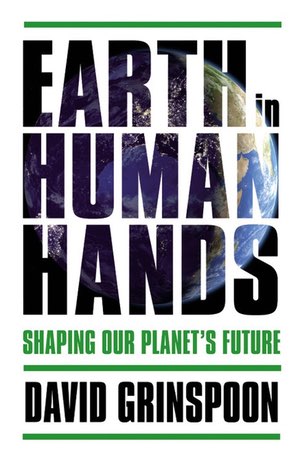Review: Earth in Human Handsby Jeff Foust
|
| “We should regard ourselves as apprentice planetary engineers,” he writes. |
That data, collected by satellites and other instruments, show that the climate is changing as human activity has pumped large amounts of carbon dioxide into the atmosphere. At the same time, humans have altered the planet in many other ways, even without intending to do so. If humanity it to survive and prosper in the long term, argues David Grinspoon in his excellent new book Earth in Human Hands, humanity will have to take deliberate steps to alter the Earth in different ways.
Grinspoon, a planetary scientist and astrobiologist who was the first Chair of Astrobiology at the Library of Congress, argues in the book that it is not unreasonable to think that life can reshape a planet: life has altered the Earth since the first lifeforms emerged, from the creation of minerals that would not be produced by abiotic processes to the “snowball Earth” of 2.1 billion years ago when the rapid influx of oxygen into the atmosphere from primitive life wrecked the methane-based greenhouse effect keeping the planet warm. Grinspoon calls those effects planetary change of the “second kind,” with the first kind reserved for “random” events, like volcanic eruptions and asteroid impacts.
That humans can alter the planet is thus not surprising; what is unprecedented, though, is the rate of change, such as the surge of carbon dioxide levels in the atmosphere. This is what he calls planetary change of the third kind, or “inadvertent change”: humans didn’t intend to reshape the planet and alter its climate as part of industrialization, but rather this was a byproduct. This ultimately, he argues, will require planetary change of the fourth kind: intentional action to mitigate the damage the inadvertent change has caused. Such changes have already taken place. He notes the international accords to end the use of chlorofluorocarbons that were damaging the ozone layer; the ozone layer, in danger of being depleted a few decades ago, is now on the rebound.
Grinspoon doesn’t endorse any specific technical solutions to climate change or other threats to the Earth in the book, other that to caution about taking rash steps. “We should regard ourselves as apprentice planetary engineers,” he writes, “easing up on those behaviors that have been throwing the system out of balance, taking those steps we know are safe, and learning all that we can about how the system works so that by the time we need to call upon more intensive interventions, we will be ready to do so safely and wisely.”
Earth in Human Hands is not just a book about climate change, but instead about the need to become “apprentice planetary engineers” because, he argues, we have “no choice at this point but to engineer Earth” for our survival. For example, he touches upon planetary defense from asteroid and comet impacts (planetary changes of the first kind); while not an imminent threat, it’s something that “will eventually be our undoing” if we don’t address it.
| Could the lack of detections of alien civilizations say something about the difficulty in dealing with planetary change of the third kind? Or, could that silence mean that they react to it in a different way? |
Grinspoon writes about a wide range of subjects in the book beyond simply the threats to life on Earth today. He discusses planetary science, including how studies of Mars and Venus have contributed to our improved understanding of the Earth. Models of the Martian atmosphere, developed to understand dust storms there, later helped scientists understand how an asteroid impact could wipe out the dinosaurs 65 million years ago, and how even a “limited” nuclear war could lead to global disaster through a nuclear winter.
There’s also a long discussion about the search for extraterrestrial intelligence (SETI) in the book. Could the lack of detections of alien civilizations say something about the difficulty in dealing with planetary change of the third kind? Or, could that silence mean that they respond in a different way, taking a more sustainable approach versus exponential growth? A chapter that followed on what’s sometimes called Active SETI—sending messages to other stars, rather than just listening—is interesting, but seems like a tangent to the book’s broader theme.
The message of Earth in Human Hands is clear: humans are already, unintentionally, reshaping the Earth, so it’s time to think about how to intentionally make changes to undo that damage. It’s an issue that will take advantage of our space expertise as well, from satellites monitoring our planet and studying other worlds from which to draw insights, to scanning the skies to see if anyone else out there has managed to survive their own planetary change of the third kind.
